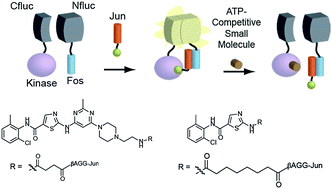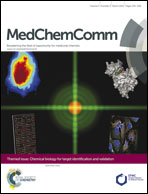When tight is too tight: Dasatinib and its lower affinity analogue for profiling kinase inhibitors in a three-hybrid split-luciferase system†
Abstract
The development of methods for profiling inhibitors of protein kinases has seen tremendous progress over the last decade. We have previously reported a split-luciferase based three-hybrid approach for determining kinase inhibitor selectivity that utilized the promiscuous staurosporine warhead for designing chemical inducers of dimerization (CID). Herein we describe the extension of this methodology to target the tyrosine kinase (TK) group using a Dasatinib warhead based CID. We found that though the Dasatinib enabled CID provided a means for assembling the split-protein fragments, it had too tight an affinity in the context of the three-hybrid system for several TKs and could not be displaced with inhibitors. By tuning the affinity of Dasatinib, we were able to successfully target multiple TKs that could subsequently be assayed for inhibition by small molecules. We further demonstrated that the new CID allowed for the screening and identification of inhibitors against ABL.


 Please wait while we load your content...
Please wait while we load your content...